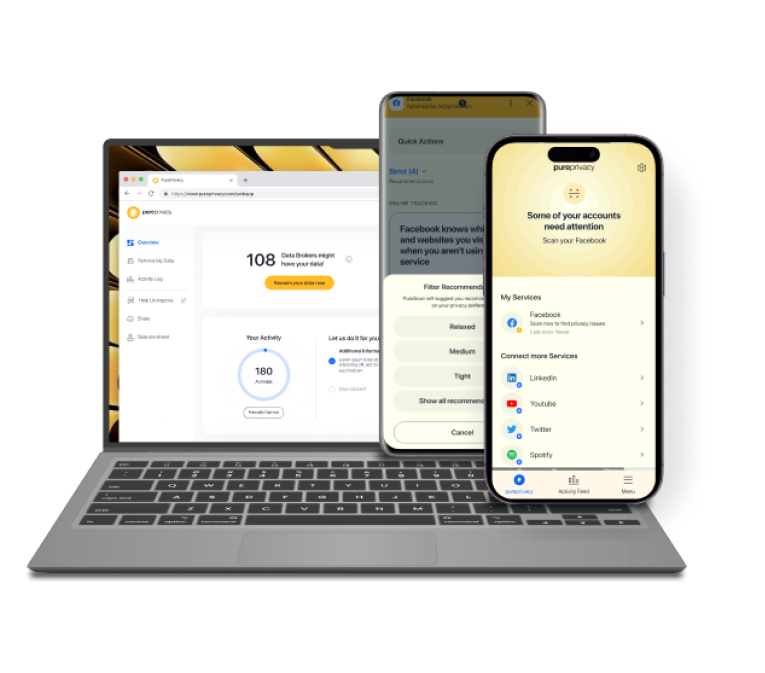Table of Content
- What Happened in the Capgemini Data Breach?
- What was the Impact on Capgemini Customers?
- What are the Potential Privacy Risks from Exposed Data?
- How to Take Immediate Action in Case of a Data Breach
- Protect Your Data from Malware Attacks With PurePrivacy
- Frequently Asked Questions (FAQs)
- Wrapping Up!
A notorious hacker named “grep” got access to API keys, staff information, and VM logs of T-Mobile.
Capgemini, a French technology company, has suffered a security breach that resulted in the theft of 20GB of sensitive data.
And this data leak can potentially reveal network connections, security events, critical system activity, and user behavior.
This incident raises major concerns about the security of our online networks and its potential consequences for both individuals and corporations.
Discover if Your Most Critical Identifiers Have Been Exposed on the Dark Web
Receive timely alerts and actionable insights with PurePrivacy's Dark Web Monitoring.
What Happened in the Capgemini Data Breach?
In September 2024, Capgemini, a worldwide IT services and consulting organization, experienced a severe cybersecurity compromise.
A hacker using the alias "grep" claimed to have gained unauthorized access to Capgemini's servers and taken significant amounts of sensitive data.
Capgemini Data Breach is real. 20GB of data including T-Mobiles Virtual Machine logs. pic.twitter.com/xrHzbJ7bKA
— ?️? (@MiniTuxedo) September 10, 2024
While Capgemini has yet to publicly confirm the breach or disclose specific details about its scope, the exposed data has generated severe worries about the company's system security and potential impact on its clients.
If the hacker's allegations are genuine, the breach may have compromised sensitive information from a variety of firms, including those in highly regulated industries such as finance and healthcare.
What was the Impact on Capgemini Customers?
Many customers were concerned about the security of their data and the possibility of identity theft or financial loss.
Further, the hack harmed Capgemini, raising concerns about the company's ability to protect its clients' data.
So far, the organization has remained silent, refusing to confirm or refute the hacker's claims. There are no statements on the company's website, X, or LinkedIn profiles.
What Type of Data Exposed in This Breach?
The data breach allegedly includes databases, source code, private keys, credentials, API keys, projects, and personnel information of 20GB.
The archive also includes backups and cloud infrastructure configuration details for Capgemini clients.
? BREAKING: Capgemini hit by a major data breach! ?
— SaiSanjay ?|| B+ (@SaiSanjayAAdhf) September 11, 2024
? Exposed: 20 GB of sensitive data including source codes, credentials, project files, and more.
? September 2024 ?️ Involved companies: T-Mobile logs also leaked.
Ioc : Company databases
-Source codes
-Private keys… pic.twitter.com/InT396Vdqf
Grep stated in the forum post:
"They had more data but I decided to exfiltrate only big files, company confidential, Terraform, and many more."
The criminal also released a few samples, including claimed T-Mobile virtual machine records.
The full data set was made available on BreachedForums for a modest fee of 8 credits, which translates to a small amount of real money and is used by hackers as a filter to ensure that only registered forum users have access to it.
What are the Potential Privacy Risks from Exposed Data?
The following are some of the most typical difficulties that organizations of all sizes face when attempting to secure sensitive data.
Phishing and Other Social Engineering Attacks
They involve misleading or influencing someone into disclosing confidential information or gaining access to private accounts.
Ransomware
Ransomware is software that infects corporate devices and encrypts data, making it unusable without the decryption key.

SQL Injection
SQL injection (SQLi) is a prevalent technique used by attackers to obtain unauthorized access to databases, steal data, and carry out undesirable activities.
Unintentional Data Exposure
A vast number of data breaches are triggered by the irresponsible or accidental release of sensitive data, rather than a deliberate attempt.
How to Take Immediate Action in Case of a Data Breach
A data breach can have serious consequences for both individuals and corporations.
Here's what you should do if you suspect or find a breach:
Isolate Impacted Systems
Disconnect the affected systems from the network to avoid additional data loss.
Change Passwords
Change passwords immediately for any impacted accounts, including administrative ones, and Monitor your network for illicit activity.
Remediate and Improve Security
Address any security flaws that could have led to the breach. Review and improve your organization's security practices to avoid future intrusions.
Identify Compromised Data
Determine what type of data was compromised, such as personal information, financial data, or intellectual property.
Notify Affected Parties
Follow your jurisdiction's notification rules for data breaches.
Protect Your Data from Malware Attacks With PurePrivacy
PurePrivacy is a complete security solution that protects your data and prevents you from the continually shifting risks posed by malware. PurePrivacy provides peace of mind by protecting your online activities and personal information with a solid and trustworthy security layer.
- Use Dark Web Monitoring to Continuously analyze the dark web for your personal information to detect potential data breaches.
- Use Tracker Blocker to prevent websites and third-party trackers from gathering and using your browsing information.
- Use Remove My Data to allow you to remove your personal information from data broker websites and search engine results.
- Use Social Privacy Manager to get detailed control over your social media privacy settings.
Scan the Dark Web
Get timely alerts and proactive solutions to protect your identity and avoid additional damage.
Tracker Blocker
Enhance your privacy by preventing targeted advertising from invading your online experience.
Remove My Data
It reduces your internet activity and lowers the likelihood of identity theft and unwanted marketing by removing your data from data brokers.
Social Privacy Manager
It helps you protect your personal information and online reputation on prominent social media platforms.
Frequently Asked Questions (FAQs)
-
What steps can I take to secure my data?

Those affected by the attack should keep an eye on their accounts for strange behavior and consider adopting precautions such as changing passwords and setting two-factor authentication.
-
What happens if your company's data is breached?

A data breach jeopardizes financial records and personal information, potentially leading to identity theft and drowning in false charges. For obvious reasons, a data breach may be devastating for any firm that encounters one.
-
How long does it take to file a data breach claim?

A data breach compensation suit could take several months or years to resolve. If the conditions are generally clear and the organization accepts a settlement, the process will move significantly faster.
-
What types of data can be leaked?

Here are the data kinds commonly discovered in data leaks: Personally identifiable information (PII) refers to any information or data that can be used to identify or locate a person.
Wrapping Up!
T-Mobile was badly hit with multiple data breaches back in 2023, which impacted more than 37 million customers.
And this Capgemini's data breach underlines the vulnerability of even huge organizations to cyberattacks.
It emphasizes the significance of strong data security methods for protecting sensitive information.
Consider using PurePrivacy with a VPN for powerful encryption technology that keeps your data private and secure against unauthorized access.





